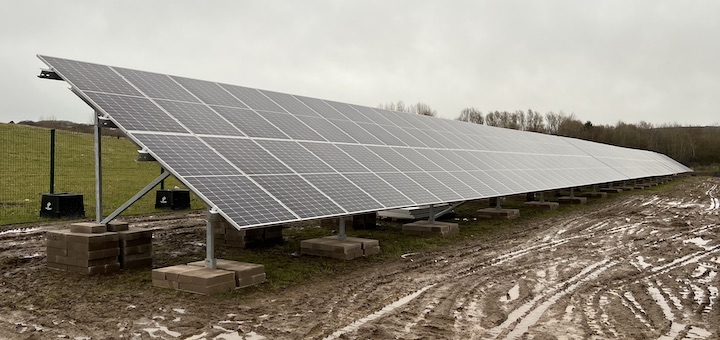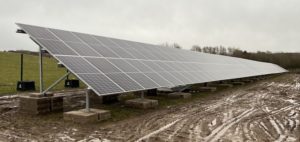If there’s a climate emergency, shouldn’t we have an emergency response? Mark Davies discusses how Lancaster City Council has been using the principles underlying the Civil Contingencies Act to help achieve its challenging net-zero target.
 As I write, Lancaster City Council’s leisure centre and swimming pool are entirely off gas and are drawing electricity from a solar farm built on an adjacent landfill site. This one intervention has reduced the council’s CO2 emissions by 12%. The capital cost of this will be £4.8m, funded by a successful bid to the government’s Public Sector Decarbonisation Fund.
As I write, Lancaster City Council’s leisure centre and swimming pool are entirely off gas and are drawing electricity from a solar farm built on an adjacent landfill site. This one intervention has reduced the council’s CO2 emissions by 12%. The capital cost of this will be £4.8m, funded by a successful bid to the government’s Public Sector Decarbonisation Fund.
The council’s wider capital programme provides for the whole of the council’s fleet of 150 vehicles to be electric by 2030 and includes provision for the needed infrastructure changes. We have plans for all our municipal buildings to be off gas by 2030 and are currently reviewing our recently approved Local Plan to ensure development reflects the need to address the climate emergency.
All the above, and much more, have significant costs. Having a clear local strategy means we have been able to successfully bid for government funding and have received nearly £7m in total in the past 12 months.
Net zero by 2030
Good progress has been made, but we need to do much more given the challenging target we have set ourselves. On 30 January 2019, Lancaster City Council declared a climate emergency after elected members unanimously voted to make the council’s activities net zero by 2030 and to work with other agencies to make the whole district of Lancaster zero carbon within the same timescale.
To give an idea of the scale of the challenge, Lancaster City Council’s direct CO2 emissions as an organization in 2019 were 3,015 tonnes. The district of Lancaster – including Lancaster, Morecambe, Heysham and Carnforth and with a population of around 150,000 – produced 750,000 tonnes of CO2.
To date, around 300 councils have declared climate emergencies. Declarations vary both in terms of scope of intent and timeframes.
The government has a target of net zero by 2050 and in 2035 intends to have cut emissions by 78%, compared with 1990 levels. UK total net emissions in 2019 were estimated to be 351.5 million tonnes.
This creates a significant challenge for councils that have declared their intent to address the emergency of climate change, and indeed those that have not. Not declaring an emergency does not mean the issue will go way.
On 30 January 2019, Lancaster City Council declared a climate emergency after elected members unanimously voted to make the council’s activities net zero by 2030 and to work with other agencies to make the whole district of Lancaster zero carbon within the same timescale.
22 March 2022
The Marriott Hotel, Leeds
LATIF North
Lead sponsor: CCLA
Qualifying finance officers can register free of charge here
Climate change in the context of Covid-19
A further challenge is that this emergency has to be tackled within the context of recovery from the pandemic, increasing demand, rising living costs, economic uncertainty and widening inequalities.
As the lead officer for climate change at Lancaster, I was particularly drawn to the use of the word “emergency” in these declarations. The UK government has set out laws and guidance that councils and partner agencies, such as the police and fire and rescue, must follow in the event of emergencies.
The Civil Contingencies Act 2004 and the responsibilities it places on agencies are well understood and we frequently see practical application in responses to all manner of emergencies. We saw national strategies applied during the pandemic, and indeed the government added further legislation to ensure that the focus remained on tackling the emergency.
The government’s guidance that accompanies the Civil Contingencies Act 2004 sets out principles of effective response and recovery to an emergency. It seemed logical in Lancaster, therefore, to think about how these could be applied to addressing the emergency of climate change. Other councils may want to consider taking a similar approach.
Subsidiarity: Decisions and actions should be taken at the lowest appropriate level, with coordination at the highest necessary level. The principle is that local agencies are the building blocks. The response to the pandemic demonstrated the key role of communities. How well engaged, supported and resilient are our communities, parishes and local networks to contribute to addressing climate change?
Direction: Clarity of purpose comes from a strategic aim and supporting objectives that are agreed, understood and sustained by all involved. Without clarity, time and effort are wasted at the expense of those directly affected by the emergency.
Information: Accurate information and appropriate information management systems are key to effectively dealing with any emergency. Data is critical to understanding the emergency and therefore addressing it. How well do we understand where the biggest gains will be made?
Integration: Effective coordination should be exercised between and within organisations and levels (i.e., local, sub-national and national) to produce a coherent, integrated effort. There are major gains to be made here. Very specialized skills are required to analyse data, provide options for projects, work with utility network providers and deliver projects. Would it provide a better outcome if councils pooled their resources to develop teams to coordinate a response across a bigger footprint? Could procurement of electric vehicles and air source heat pumps be better coordinated? How do we integrate our responses with limiting factors like local grid capacity?
What the pandemic demonstrated overwhelmingly is that tackling an emergency of an international scale requires clear national strategies and the resources to deliver them.
Local authorities have shown clear leadership in mobilising to address climate change in their areas, not just in terms of addressing their own carbon footprint as organizations but in showing leadership that influences other organisations, businesses and communities.
The pandemic has shown that councils are well placed to lead and coordinate emergency responses in their communities. Councils have also demonstrated that, given the resources, they can structure themselves as a group and individually in sophisticated ways to ensure efficiency.
Funding rounds like the Public Sector Decarbonisation Fund are very welcome and do showcase innovation and best practice. But what the pandemic demonstrated overwhelmingly is that tackling an emergency of an international scale requires clear national strategies and the resources to deliver them. The biggest inroads from councils would be made through long-term sustainable financial settlements that would ensure that every council has sufficient resources to exercise its roles and responsibilities and to meet the needs of its community.
In the case of climate change, there are obviously many other players besides councils, all of which require resources to be able to make the scale of contribution that is needed. Councils are uniquely placed, however, to ensure a coordinated and effective response.
Provide the resources and they can deliver.
Mark Davies is director for communities and environment at Lancaster City Council.
—————
FREE weekly newsletters
Subscribe to Room151 Newsletters
Room151 LinkedIn Community
Join here
Monthly Online Treasury Briefing
Sign up here with a .gov.uk email address
Room151 Webinars
Visit the Room151 channel















